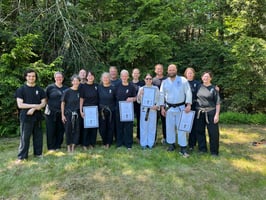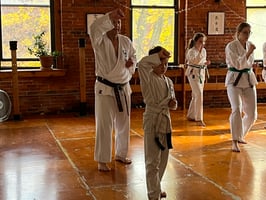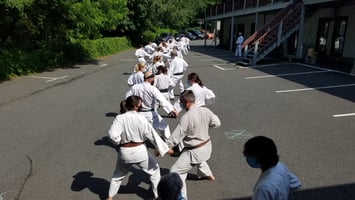Karate concepts in my life I think about karate a lot. Definitely more than 5 years ago when I...
Working together
Have you ever stopped to think why, in all of our classes, we have multiple ranks mixed together?
It’s about students helping each other, looking out for each other, and helping to pass on the knowledge of the dojo to each other.
Yes, there’s an instructor at the front of the room leading the group, sharing information and offering corrections. But if you’re learning a new technique or a new kata, they’re probably far from the only person you’re learning from. You’re likely looking at students around you who are a little more advanced than you, who already know the technique and who are role modeling how to execute it well.
Learning from other students should extend outside the structure of a class as well. Practicing in isolation or without contact during COVID did a great deal of damage to our habit of helping each other out and to our understanding of why it matters.
Nowadays, we all step on the deck before class and work our kata by ourselves, coming together only when called to do so by the instructor. Many newer students have never known any differently, and the rest of us have forgotten how it used to be.
Here’s what we used to do, and what I’d like us to get back to:
Show up 5 to 10 minutes early and find a person to train with. By “find” I mean, is someone on the deck by themselves? Yes? Then go up to them and bow in, and start working whatever kata the lower-ranking person is doing. If you are the lower-ranking person and you have a specific question about a technique or kata or yakusoku, ask it, and you can work that. You can even go up to someone of the same rank, and work together on whatever the kata is that you are working. It’s also a good time to work on yakusoku. Not too much talking, but a little bit of discussion to clarify a question is OK.
That’s it.
This is such a good way for both parties to learn. If you’re the lower-ranking person, you get extra practice with a person who knows more than you. They may have struggled with the same thing you have and may have really great advice. Or they may have impeccable technique you can copy. You’re going to get better faster because instead of struggling along by yourself, someone shared their knowledge.
And the higher rank gets something out of it too — nothing shores up your technique like explaining and showing it to someone else. And isn’t it great to see the lightbulb go on above someone’s head because of something you did to help them?
Notice, also, that this whole time I’m saying lower and higher rank, I haven’t specified what belt color we’re talking about — and that’s because it doesn’t matter. A one-tip knows more than a white belt. A brown belt knows more than a green belt.
Some of the biggest breakthroughs I’ve had in my practice have been times when folks noticed me flailing and helped me figure something out before or after class: A group of us working on pinan yondan bunkai before and after class to get it down; a black belt who ran through yakusoku with me after class for several weeks to get me over being so intimidated by partner work when I was a green belt.
Keep an eye on your fellow students. If they’re working on something and it looks like you might have a way to help them, offer. And if someone offers to help you, take it in the spirit of our practice, as one student looking out for another and a sincere attempt to lift your level by sharing their knowledge.
Thanks to Senseis Sullivan and Carvalho for the discussion that prompted this.




Leave a comment